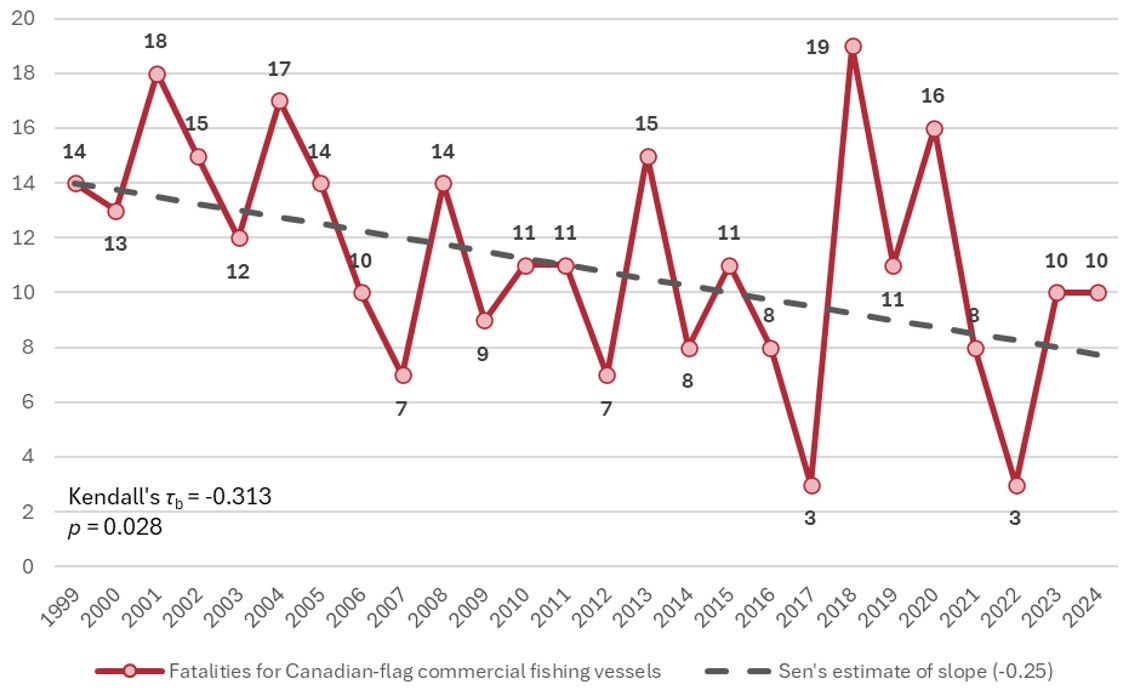Commercial fishing safety
Despite years of attention, unsafe conditions continue to put thousands of Canadian commercial fish harvesters—and the communities that rely on them—at risk. It was added to the Watchlist in 2010 and remains there today.
The situation
The Transportation Safety Board of Canada (TSB) has monitored commercial fishing safety since 1999. Despite various initiatives that have sparked the development of a safety culture within the commercial fishing industry, the same safety deficiencies on board fishing vessels persist. In 2012, the TSB’s safety issues investigation (M09Z0001) revealed systemic factors behind fatal fishing vessel accidents that continue to require attention:
- Vessel modifications and stability risks: Many vessels undergo structural or operational changes without proper stability assessments. For small vessels (15 GT and under), there are currently no defined criteria for what constitutes a major modification, leaving authorized representatives (ARs) without clarity on when to seek pre-approval or expert evaluation.
- Lack of stability knowledge and training: While Transport Canada (TC) does provide some guidance to help ARs and masters identify major modifications made to vessels, the guidance is qualitative and requires knowledge of stability to interpret it correctly.
- No centralized record of vessel modifications: Without a maintained and accessible history of vessel changes, it is difficult for ARs, masters, and regulators to evaluate current stability and safety conditions—especially when vessels change ownership.
- Lifesaving equipment not used or maintained: Despite being available, some lifesaving equipment, such as immersion suits and, in particular, personal flotation devices (PFDs), are often not worn or are not worn correctly. Other critical equipment, such as emergency signaling devices or life rafts, may not be properly maintained.
- Unsafe work practices: Hazardous routines—such as working alone, operating in poor weather, or handling gear without proper training—remain common.
- Inadequate regulatory oversight: Enforcement of safety regulations is inconsistent across regions. Voluntary compliance and limited surveillance mean that unsafe vessels may continue operating without intervention.
Number of occurrences
Commercial fishing continues to rank among the most dangerous occupations in Canada, with the majority of fatalities being preventable.
From 2010 to 2025, the TSB investigated 27 commercial fishing-related occurrences, which revealed recurring unsafe conditions. In this period, there were 143 fatalities from 97 accidents (Figure 1).
Action taken
Watchlist issues are complex and require coordinated action from operators, regulators and other stakeholders. While some progress has been made, much more is needed. The following steps have been taken to date.
Regulatory activities
The implementation of the Fishing Vessel Safety Regulations and the Navigation Safety Regulations, 2020 by the fishing industry were supported by TC through policy guidance, outreach, and programs. While fish harvesters are generally aware of these regulations, many lack knowledge of specific requirements and measurable safety gains have yet to be shown.
Phase 2 of the Fishing Vessel Safety Regulations (Parts III and IV), which will address vessel design and construction requirements, has not yet been published in Canada Gazette, Part I but is expected in spring 2026. The status of further amendments to the Large Fishing Vessel Inspection Regulations, originally planned for 2023, remains unknown.
Industry and community momentum
Actions have been taken to develop a sound safety culture in the Canadian commercial fishing industry, but they have been inconsistent from region to region and even from one fishing community to the next. For example:
- Some fish harvester associations have taken proactive leadership roles, introducing guidelines for vessel modifications and stability, developing codes of best practices for their fisheries, and providing subsidies for safety equipment.
- Several provincial workers’ compensation boards have strengthened their approach to safety, increasing education and enforcement efforts, imposing fines to discourage unsafe work practices, and collaborating with other provincial organizations to launch education initiatives.
Action required
The TSB has issued 55 recommendations pertaining to fishing vessel safety. The 2025 assessments of the responses to the 10 active recommendations are as follows:
- Unable to assess: M23-08
- Unsatisfactory: M16-01, M16-03,
- Satisfactory in part: M08-04, M16-02, M16-05, M22-01, M23-07, M23-09
- Satisfactory intent: M23-06
The issue of commercial fishing safety will remain on the Watchlist until there is demonstrable progress on these key indicators:
- Coordinated regulatory oversight: TC and the Fisheries and Oceans Canada collaborate to ensure fish harvesters meet all requirements before operating commercially. Federal and provincial authorities also coordinate regulatory oversight of commercial fisheries.
- Promotion of stability guidelines: TC, provincial workplace safety authorities, and fish harvester associations promote existing user-friendly guidelines on vessel stability designed to reduce unsafe practices.
- Sound safety culture: Fish harvesters demonstrate that they are taking ownership of safety, specifically with respect to the use of stability guidelines, PFDs, immersion suits, emergency signaling devices, and safe work practices.

